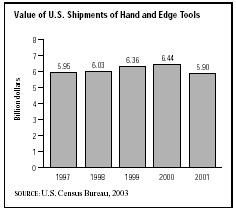SIC 3423
HAND AND EDGE TOOLS, EXCEPT MACHINE TOOLS AND HANDSAWS
Firms in this industry manufacture simple, edged hand-tools such as files, axes, chisels, prying bars, rulers, soldering irons, tongs, rakes, and cutters for metalworking, woodworking, and general maintenance. Saws and saw blades are discussed in SIC 3425: Saw Blades and Handsaws, while metal-cutting dies and power-driven hand tools, attachments, and accessories appear under the major group for industrial and commercial machinery and computer equipment.
NAICS Code(s)
332212 (Hand and Edge Tool Manufacturing)
According to the U.S. Census Bureau, less than 1,000 establishments operate in this category. Industry-wide employment totaled 53,345 workers receiving a payroll of more than $1.8 billion in 2000; 39,106 of these employees worked in production, putting in almost 75 million hours to earn wages of more than $1.11 billion. Overall shipments for the industry were valued at almost six billion dollars in 2001.
Houston, Texas-based Cooper Industries Ltd. led the industry with 2003 sales of almost $4.1 billion and 27,188 workers. Danaher Corp., based in Washington D.C., followed with 2003 sales of more than $5.2 billion created by 30,000 employees. Rounding out the top three industry leaders was Stanley Works of New Britain, Connecticut, with more than $2.6 billion in 2003 sales generated by 13,500 employees. Using stereolithographic models from CAD drawings and infrared photography, Stanley had introduced a new line of tools with ergonomically redesigned handles in mid-1999. Other industry leaders included SPX Corp. of Charlotte, North Carolina, with sales of five billion dollars and 22,200 employees in 2003; Snap-On Inc. of Pleasant Prairie, Wisconsin, with 2003 sales of $2.2 billion and 12,400 workers; and Toro Co. of Bloomington, Minnesota, with 2003 sales of $1.4 billion and 4,944 workers.
The industry provides basic hand tools for both domestic and professional use. According to the U.S. Census Bureau, industry shipments climbed from $5.95 billion in 1997 to $6.44 billion in 2000, before falling to $5.90 billion in 2001. Mechanics' hand service tools accounted for 36.7 percent of total industry shipments in 2001. Dies and interchangeable cutting tools for machines and power-driven hand tools account for 15.7 percent of shipments; precision measuring tools, such as inspection and quality control devices, 12.3 percent; and hand-operated edge tools, 8.7 percent.
Traditionally, production in this industry was centered in the New England area, paralleling the development of SIC 3421: Cutlery. In the early 1900s, Massachusetts and Connecticut commanded 47 percent of the hand and edge tool and cutlery industries. The shift toward mass-production techniques and away from a reliance on skilled craftsmen, however, resulted in the increasing movement of the hand and edge tool industry to the heartland states.

The industry tended to follow the source of cheap materials and markets, differentiating it from cutlery by its marked westward migration. In the early 2000s, the four main states producing hand and edge tools were Ohio, Minnesota, Connecticut, and South Carolina.
Employment figures for 2000 show that the industry was experiencing moderate growth at the turn of the twenty-first century. According to the U.S. Census Bureau, the number of industry employees increased modestly from 50,598 to 53,345 between 1997 and 2000. Payroll also increased from $1.63 billion to $1.81 billion during those years.
Further Reading
U.S. Census Bureau. "Statistics for Industry Groups and Industries: 2000." February 2002. Available from http://www.census.gov/prod/2002pubs/m00as-1.pdf .
——. "Value of Shipments for Product Classes: 2001 and Earlier Years." December 2002. Available from http://www.census.gov/prod/2003pubs/m01as-2.pdf .
Comment about this article, ask questions, or add new information about this topic: